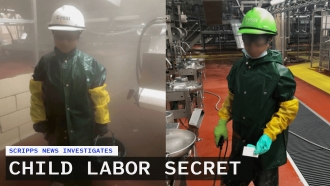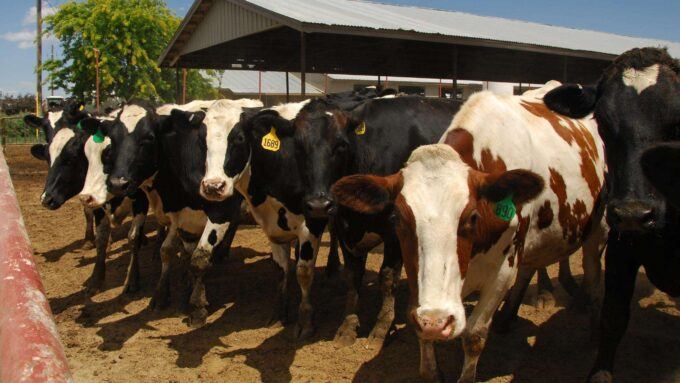As a Latina Vegan, I’m Decolonizing a Cruel & Racist Food System
Story by Lauren T. Ornelas, As Told To Nicole Froio •
Growing up in Texas in the 1970s, I spent long periods away from my mother. My parents divorced when I was 4 years old, so my mom raised my sisters and me by herself. To make ends meet, she spent long hours at work, trying to earn enough money to feed, clothe, and house us. That meant other people in the community took care of us during the day. While my mother was away, I would watch the cows on the hillside, and I would think about how sad it must’ve been for the mother cow to come home and not find her baby there anymore. In this sense, I saw myself in these animals, and I didn’t want to be responsible for disrupting any family of cows the way capitalism was interrupting mine.
As an elementary school student, it was my innate connection to non-human animals like cows, and my understanding of the harms of raising and slaughtering calves, that moved me to become a vegetarian. But, as a kid, it was difficult for me to stick with this diet, mostly because of my family’s financial restraints. Sometimes, all we could eat was what others donated to us or what our school served us, and that often included meals with meat. I realized then that poverty prevented me from eating my ethics and that I didn’t have the freedom to eat how I wanted to.
Being Chicana, I’ve long known that food is political, even if it shouldn’t be. My mom supported the Delano Grape Strike, a labor movement the predominantly Filipino organization Agricultural Workers Organizing Committee (AWOC) launched against the grape growers in Delano, California, in 1965, California, to fight against the exploitation of farmworkers. She boycotted non-union grapes and taught me about the impact of labor exploitation on the bodies and minds of farmworkers. By the time I got to high school, I was getting involved in the anti-apartheid movement in South Africa. I learned that I could make a difference from far away, that, like my mom, one of the things I could do was boycott companies with vested interests in the apartheid regime, so I did.
For me, food, animal rights, and racialized liberation struggles have always been linked, but I learned early that not everyone recognized the interconnectedness of this violence. In 1987, I was excited to get involved in the animal rights movement. But my elation was stolen by the reality of white supremacy within the movement. My colleagues regularly brought me out as a token Latina vegan in order to shame my people into veganism or to prove that the vegan movement wasn’t only white; however, these same folks rarely listened to me when I discussed why Latines don’t always have the access to plant-based foods or the labor struggles of farmworkers. Instead, they pitted animal rights and human rights against each other, as if I couldn’t care about and work on both at the same time. For decades, I did work I believed in while feeling exploited and misunderstood by organizations and people who were supposed to be my comrades.

As a Latina Vegan, I’m Decolonizing a Cruel & Racist Food System© Provided by Refinery29
Then, in 2006, while I participated in the World Social Forum in Caracas, Venezuela, I felt seen, understood, and affirmed for the first time. I was sharing space with people who looked like me, sounded like me, and shared both my passion for the work and grievance with how it was being carried out. They, like me, understood how the lack of human rights is inherently linked to the lack of rights for non-human animals. There, surrounded by fervor and gripe, I realized that if we wanted to be a part of a movement or organization that cared deeply for all living beings, we would have to take matters into our own hands.
Later that year, I founded the Food Empowerment Project, an organization that seeks to create a more just and sustainable world by recognizing the power we have as food eaters. Through the publication of free, accessible, and culturally sensitive resources on our website, we encourage ethical food choices. We published our first big resource, Vegan Mexican Food, in Spanish and English in 2007, making Mexican recipes available to everyone looking to practice veganism without losing their cultural foods in the process. But more than just veganized recipes, this resource discusses the changes in our diets that took place due to colonization, to explain the introduction of farmed animals into the Americas, and to take us back toward a food system that is free from the exploitation of humans and non-human animals.
Education, a people-animal-land liberation politic, and advocacy are all at the root of this work. Growing up experiencing food apartheid, I know that being vegan isn’t easy for people who are lower income or who live in food deserts. I also know that many people in my community, largely impoverished migrants and people of color, work in the food industry with little-to-no labor protections. As such, we often experience the harms of the non-ethical food production practices. In terms of food consumption, Black, Latine, and Indigenous people are the most impacted by lack of access to healthy foods and, as a result, struggle with higher rates of dietary diseases. When it comes to food labor, cycles of poverty leave our communities with few career paths outside of farm work, forcing us to toil for low wages and no paid time off at companies that break labor laws with impunity.
Through the Food Empowerment Project, we see how these struggles are interconnected and fight against abuses of both human and non-human animals. Through working with community organizations, conducting original surveys and studies, and sharing our findings with local politicians, we increase access to healthy food options where they are absent. Similarly, we advance the rights of farmworkers by supporting legislative and regulatory changes as well as corporate efforts led by the laborers. And we promote ethical veganism through education, outreach, and resources.
We owe young people direct changes, as quickly as we can, to make up for the horrors that we’ve been wreaking on each other, on the planet, and on non-human animals. With the Food Empowerment Project, I am committed to pulling at all of the threads of oppression, tugging at them until everybody’s free.





